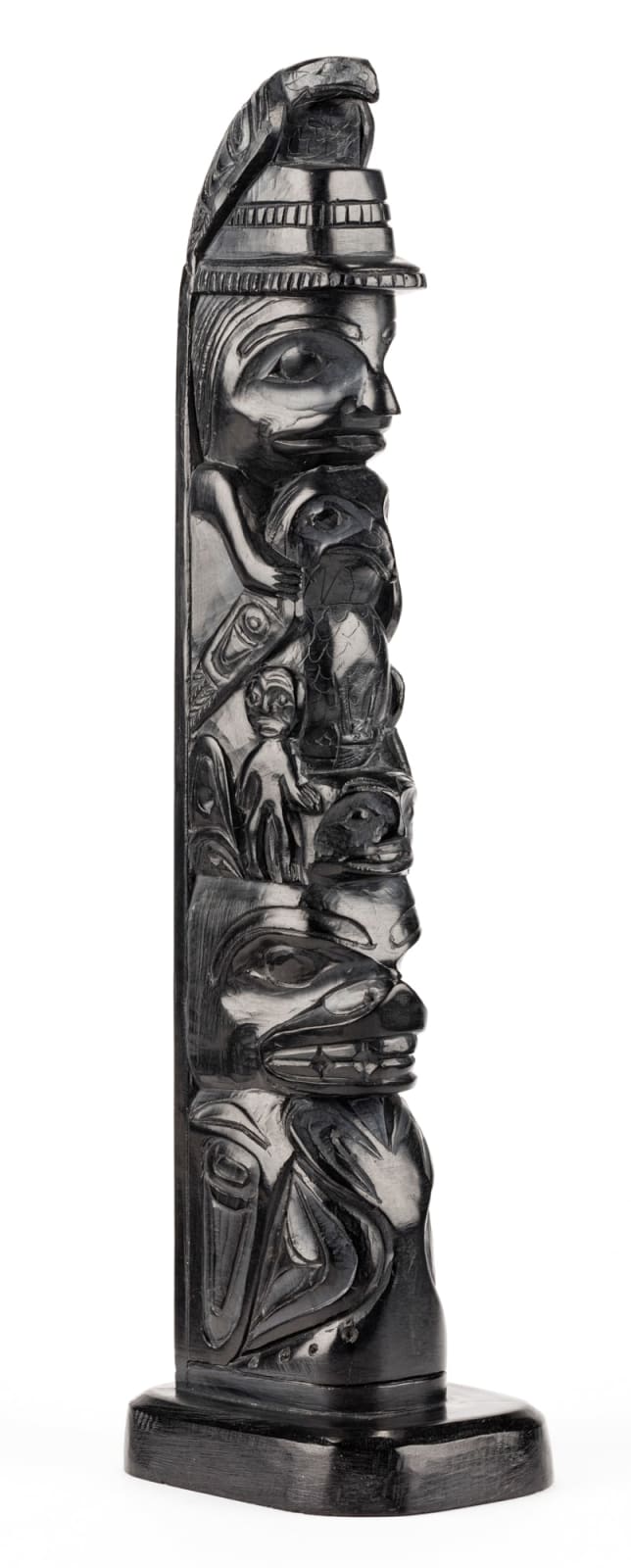-
Artworks
THOMAS MOODY (c. 1877-1947) SKIDEGATE, B.C.
Model Totem Pole, 2 December 1936argillite, 8.75 x 2 x 2.5 in (22.2 x 5.1 x 6.3 cm)
inscribed, signed, and dated, "CARVED BY THOMAS MOODY / SKIDEGATE MISSION, B.C. / DEC 2nd 1936."LOT 116
ESTIMATE: $2,000 — $3,000
PRICE REALIZED: $1,920.00Further images
By the time Thomas Moody carved this detailed model pole, the tradition founded in the half cylindrical form of a full-size cedar totem pole had morphed to abandon those limits...By the time Thomas Moody carved this detailed model pole, the tradition founded in the half cylindrical form of a full-size cedar totem pole had morphed to abandon those limits in favor of a much freer approach to the sculpture. Here, the carving is noticeably deeper than it is wide, with even more irregularity in the forward extent of the figures. Thus, provided with a greater volume of material to work with, Moody has combined two main figures with numerous small secondary images. The topmost figure, a comparatively small eagle, is perched on the primary figure’s hat with its tail represented on the plain flat back of the pole. The carver has signed and dated the sculpture on the flat back, a feature that never appeared on nineteenth and early twentieth-century historical works. The upper main figure is a human, wearing the somewhat disproportional representation of a woven spruce-root ceremonial hat. The delicate rim of the hat and the human’s nose protrude from the established depth of the profile. Beneath the human’s chin is the head of an eagle, the man’s hands resting on its shoulders, the top of its folded wings. The bird’s body and its small legs and feet are poised on top of a large human head, which in turn rests on top of the lower main figures’ head. On either side of the human head is a small standing humanoid figure, their feet resting on top of the large image below. The lower main figure is in concept a seated whale or other sea mammal. The figure’s head faces straight forward, the pectoral fins like arms extend downward, and the double-fluked tail is curved up to lay across the figure’s belly and chest. Extending upward from the whale’s head on either side is a fin-like form, positioned like a tall ear, which of course whales don’t have, but it adds to the dynamic of the sea mammal representation. There is a separate base to which the pole is attached, a square with rounded corners on the slightly beveled sides and flat top.
Steven C. Brown
References: For a discussion of the artist and his work see Marius Barbeau, Haida Carvers in Argillite, (Ottawa: Department of Northern Affairs and Natural Resources / National Museum of Canada, 1957; repr. 1974), pp. 104-107. For examples by the artist see Leslie Drew and Douglas Wilson, Argillite: Art of the Haida, (Vancouver: Hancock House Ltd., 1980), p. 254.Provenance
Private Collection, Calgary, AB.
Join our mailing list
* denotes required fields
We will process the personal data you have supplied in accordance with our privacy policy (available on request). You can unsubscribe or change your preferences at any time by clicking the link in our emails.












